By Douglas McColloch
Since its inauguration in 2013, SEMA Launch Pad has been the specialty-equipment industry’s ultimate competition for aspiring and established entrepreneurs to introduce their products to a worldwide audience.
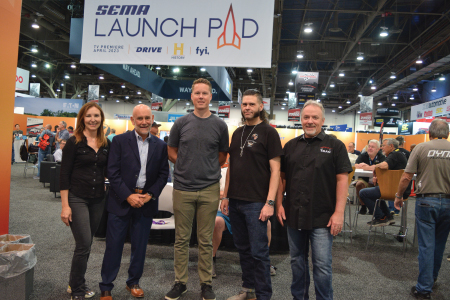
The 2022 Launch Pad finalists (from left) Susan Pieper, DMOS; Frank Terlep, Auto Techcelerators LLC; Jake Hawksworth, Hypercraft; Dustin Golat, Thread Wizard; and Kevin Robinson, TRAC LLC.
For 2022, the tenth annual SEMA Launch Pad competition attracted a record-high number of applications. From these, 15 semifinalists were chosen by a panel of industry experts. After a day of oral presentations and product demonstrations at the SEMA Garage in Diamond Bar, California, five contestants were chosen to advance to the finals, held last November at the SEMA Show in Las Vegas. We briefly recapped the event in last month’s issue, but for 2022, we decided to expand our print coverage to include a spotlight on each of the five finalists. What follows, edited for clarity and length, is a profile of each contender and a look at the unique products they’ve brought to life—all in their own words.
Jake Hawksworth
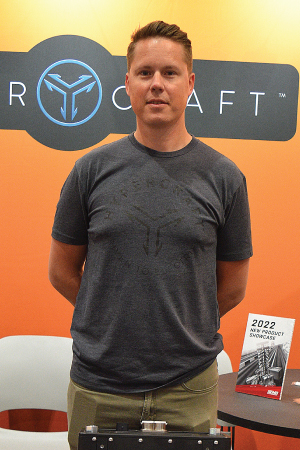 Hometown: Provo, Utah
Hometown: Provo, Utah
Job Title, Company: CEO, Hypercraft
Product: Modular vehicle battery systems
SEMA News: What’s your latest project? What’s in your driveway/garage/studio, etc.?
Jake Hawksworth: When I went into this business a year and a half ago, full-time, I sold my ’65 Falcon four-door wagon. It had a 347 stroker in it, and it was my passion project, but I sold it to focus on the business side. So currently, no projects.
SN: Tell us a bit about your background: Where you grew up, how you got into the industry, and how many years you’ve been in it.
JH: Most of my kind of school years were spent in Arizona. I was big into mountain biking. My parents were entrepreneurs and my grandparents owned a manufacturing company in Minnesota. So after high school, I moved to Minnesota and got involved in manufacturing for powersports and eventually that got me into product design and development. That’s how I spent 15 years of my early career, and that’s led me to today, which is just a passion for emerging markets, new technology and developing products that fit within gaps in the industry.
SN: What was the inspiration/motivation for your product?
JH: The original inspiration was developing an electric vehicle. And the problem we had was that there are really no good powertrains for it unless you want to take parts out of an existing vehicle like a Tesla. We wanted more of a ground-up, bespoke powertrain system and we couldn’t find it, so we ended up starting to design it and doing it in-house. And that’s what’s led us to where we are today. Now, we’re 100% focused on powertrains only and we support vehicle builders and manufacturers instead.
SN: How long did it take to develop your product? Were there any difficulties you had to work through?
JH: Well, the product is in a constant state of development because technology is evolving and changing and we will continually develop with it. But on this specific design, we’ve spent the last nine months in R&D and testing it. Now we have it in some vehicle platforms, and we’ll continue to design it even further and we’ll work on scaling the manufacturing of it.
SN: What have you learned from the Launch Pad experience that you hadn’t known before? What’s the best piece of advice you’ve received?
JH: We’re an EV company in an industry that’s been really dominated by internal combustion. And instead of people being hostile to us, they’ve been really encouraging. And the judges have been the same way—their positivity has just been amazing for us. They’ve been happy to help us along the way and hear what our problems are and to be a part of the solution.
SN: If you should win the competition, what do you plan to do with the money?
JH: The money is going to be invested right back into the product itself, and that will include some of the sales and marketing and continuing to show up to events like the SEMA Show and to get our product out there.
SN: What advice would you give to folks who are thinking about competing in the future?
JH: There’s no downside to trying. We had no idea if we were a good fit for a program like this, so we decided to enter and we just put our best foot forward, and we’re here in the top five. So I would say my best advice is, don’t think twice. Just enter and go for it.
SN: When you’re not at work, where will we find you, and what will you be doing?
JH: If I’m not working, I’m with my family. I have a wife and two young daughters, and we’re probably going to be up in the mountains in Utah camping or just out with our dogs. So just having family time.
Frank Terlep
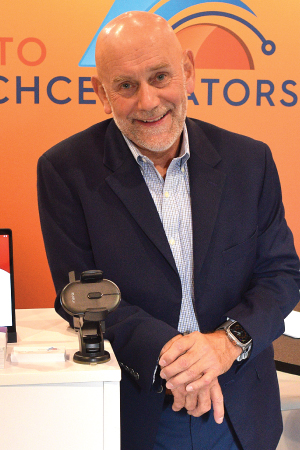 Hometown: Poway, California
Hometown: Poway, California
Job Title & Company: CEO, Auto Techcelerators LLC
Product: Test Drive CoPilot
SN: What’s your latest project? What’s in your driveway/garage/studio, etc.?
Frank Terlep: My latest project is a mobile app where a user can scan a VIN barcode or QR code and they will be presented with every ADAS system, component, component location, required calibration, what triggers the required calibration, and the app delivers OEM repair procedures, OEM position statements, ADAS videos and more.
SN: Tell us a bit about your background: Where you grew up, how you got into the industry, and how many years you’ve been in it.
FT: I grew up on the south side of Chicago and joined the Army out of high school. After my three years in the military, I attended Southern Illinois University, where I first started my auto career in their auto technology and management program. I’ve been actively working in the automotive industry since 1979 where I started as a brake and alignment technician at a Kmart auto center. I started my first company in 1985 when my partner and I raised $100,000 from an angel investor and designed and developed one of the first business management software systems for the auto aftermarket.
SN: What was the inspiration/motivation for your product?
FT: During my time as the CTO of asTech, we performed remote scanning and calibrations and at the bottom of every scan/calibration report we would tell the shop to perform a “proper test drive.” The problem was that the company never told the shops how to properly perform the “test drive,” i.e., what were the OEM validation procedures to ensure the ADAS systems operated as they were supposed to. Today, as far as we know, Test Drive CoPilot is the only platform in the world that helps the automotive aftermarket properly perform and document post-customization, repair and/or calibration of ADAS-equipped vehicles.
SN: How long did it take to develop your product? Were there any difficulties you had to work through?
FT: We started to design and develop Test Drive CoPilot in September 2019. We introduced a prototype to the industry in late February 2020. We all know what happened in March of 2020. COVID set us back almost two years, and almost bankrupted the company!
SN: What have you learned from the Launch Pad experience that you hadn’t known before? What’s the best piece of advice you’ve received?
FT: I learned that if you want to win, you need to play the game. I was hesitant to send in the initial video but because of that and being passionate about my invention, here I am—a finalist! The best piece of advice? Be yourself!
SN: If you should win the competition, what do you plan to do with the money?
FT: The first thing I will do is take Sue, my wife of 41 years, to dinner to thank her for her support and patience during the design, creation and launch of Test Drive CoPilot. The remainder of the money will be spent on PR and marketing to make sure all aspects of the auto aftermarket industry know how they can benefit from our test platform.
SN: What advice would you give to folks who are thinking about competing in the future?
FT: Go for it! If you believe in your automotive-related product or service, you need to let the world know about it, and SEMA Launch Pad is one of the best ways to get your product/service the PR and exposure it needs to become successful.
SN: When you’re not at work, where will we find you, and what will you be doing?
FT: I typically work 70–80 hours per week, but I also try to find 90–150 min. per day to exercise, workout and run or ride a bike. I also golf once or twice per week, but my handicap does not reflect all the time I spend trying to figure out the crazy game of golf.
Dustin Golat
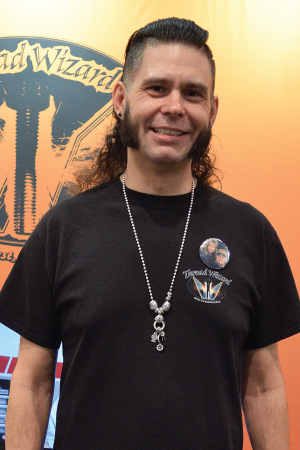 Hometown: Fairbanks, Alaska
Hometown: Fairbanks, Alaska
Job Title & Company: CEO, GolaTTaylor Tools LLC
Product: Thread Wizard Bolt Cleaner
SN: What’s your latest project? What’s in your driveway/garage/studio, etc.?
Dustin Golat: My daily driver is nothing special, a Nissan Rogue I picked up after someone T-boned my Subaru. Working in car sales for my other job, you definitely learn not to fall in love with iron, so things pass through my hands a lot. Just got rid of an SRT-8 6.1 and am currently with a ’17 Roush GT Premium.
SN: Tell us a bit about your background: Where you grew up, how you got into the industry, and how many years you’ve been in it.
DG: I have a background in production, but I feel like this is more a question about Gary Taylor, the tool’s inventor. Gary was from Port Huron, Michigan, where we manufacture our tool. Gary entered the workforce at 13 and started out in a junkyard but quickly moved to the Ford plant that employed his father and grandfather. Gary spent 50 years in the business, right until the time he passed away. He spent more than 45 of those years as a mechanic of one kind or another, working for almost every American car manufacturer at one point.
SN: What was the inspiration/motivation for your product?
DG: Gary’s inspiration came from two incidents. The first was a bolt being taken out of Gary’s hands and fired toward his face by a wire wheel on a bench grinder, narrowly missing him. The second incident involved his son Tony. An individual wire came loose out of the wire wheel as it was spinning and lodged itself into his eye after making it between his face and safety glasses. Between the two, Gary asked himself, “Why are we still cleaning bolts this way?”
SN: How long did it take to develop your product? Were there any difficulties you had to work through?
DG: The design came to Gary pretty much as you see it in the finished product. The development time of about a year to prototype was mostly twofold. Getting the exact placements of the holes, the right steel for the wire wheel and such being part of it. The other was sourcing quality U.S.-made parts and raw materials while also trying to keep costs down.
SN: What have you learned from the Launch Pad experience that you hadn’t known before? What’s the best piece of advice you’ve received?
DG: Business is a cold, hard world and you kind of get used to that reality, so it caught me off guard and warmed my heart to meet the judges and experience their desire to help others. I’d met Chip [Foose] before and thought he was a great guy, but this experience only drove that home. Both Myles [Kovacs] and Alex [Parker] gave me invaluable insight about taking marketing in-house despite not coming from that background.
SN: If you should win the competition, what do you plan to do with the money?
DG: Advertising would be one of the biggest things that prize money would help fund. Even with the internet, it can be tough trying to get word out about a brand-new tool. For us, getting it out there so people know it exists is the most crucial hurdle to long-term success.
SN: What advice would you give to folks who are thinking about competing in the future?
DG: Do it! Really, do not hesitate or think twice. I had no idea what a great experience it would be on both a personal and business level. Meeting my fellow competitors was very exciting. Each of them brought something different but top-tier to the table, and it was wonderful getting to spend some time with such innovative and hard-working people.
SN: When you’re not at work, where will we find you, and what will you be doing?
DG: 99% of the time I’ll be doing something family-related with my wife and kids. We like to go out from time to time but are usually at home playing games, making food or watching movies. The winter in Fairbanks is pretty cold, but you’ll find us having cocoa at the Santa Claus House and playing table games over hot coffee drinks.
Susan Pieper
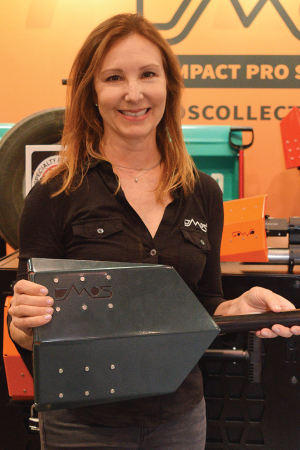 Hometown: Kettering, Ohio
Hometown: Kettering, Ohio
Job Title & Company: Founder and CEO, DMOS Collective Inc. dba DMOS Pro Shovel Tools
Product: The Delta and Stealth Mobility Shovels
SN: What’s your latest project? What’s in your driveway/garage/studio, etc.?
Susan Pieper: My latest project is building out my ’21 2500 4x4 Mercedes Sprinter Van. I want to create YouTube videos documenting the build as I know there are a lot of people who will be interested in seeing how I think through the design decisions and create something that is not like a Class A RV but more like an industrial chic garage, which allows for gear change-up based on seasonality.
SN: Tell us a bit about your background: Where you grew up, how you got into the industry, and how many years you’ve been in it.
SP: As a boat owner, I’ve sailed 10,000 ocean miles and bought everything at West Marine three times (I like to say). I’ve worked in other people’s startups after earning an MBA, but automotive is actually the newest dimension for me. Since starting DMOS, I’ve done the Rebelle Rally four times and built out a ’16 Toyota 4Runner as well as a ’17 Jeep JK. I’ve built out our DMOS Show trailer, a 12-ft. Stealth Titan Trailer that is finished in the inside, and now I’m working on my van.
SN: What was the inspiration/motivation for your product?
SP: My son was the inspiration for our shovels. My son, who’s now a pro snowboarder, was breaking his lawn and garden store shovels. I recognized that he and others needed a pro-quality tool that had purpose-built heads and was virtually indestructible and portable so he could carry it into the backcountry to build the perfect jump. DMOS was born out of this recognition and has since sold over 27,000 shovels.
SN: How long did it take to develop your product? Were there any difficulties you had to work through?
SP: It took me about a year to develop our first shovel. The hardest part was the marketing, where we had to pick a market segment and speak to it. We picked backcountry skiers and snowboarders and even got an endorsement from Travis Rice. It was hard in the following two years to pivot out of that very narrow niche, but our breakthrough moment was in 2018 when we went to our first Overland Expo in Flagstaff, Arizona.
SN: What have you learned from the Launch Pad experience that you hadn’t known before? What’s the best piece of advice you’ve received?
SP: The SEMA Launch Pad is an incredible experience. I’m grateful SEMA decided to do it, and I truly admire all of the judges who not only bring their A-game to the competition. The best piece of advice I’ve received was from Myles Kovacs who told me to “Bustle—not just hustle.” What I took by that is that bustle is making something happen whereas hustle is just working hard. He takes a “no prisoners” outlook on achieving results and I do, too.
SN: If you should win the competition, what do you plan to do with the money?
SP: We are very clear that we need to invest in sales. We have great products and, to grow sales, we need to invest in growing our wholesale business with the displays and packaging that they need as well as we need to further invest in expanding our product line into related tools and storage products to make your shovels and other essential recovery gear “always at hand and never in the way.”
SN: What advice would you give to folks who are thinking about competing in the future?
SP: Just enter Launch Pad! It is an awesome competition, program and group of passionate entrepreneurs, and I can think of no better way to grow than to put your hat in the ring next June and enter Launch Pad. Don’t ask yourself ‘if.’ Just say, why not me? And go for it!
SN: When you’re not at work, where will we find you, and what will you be doing?
SP: When not at work, you’ll find me off-roading, overlanding, mountain biking, fly fishing or, in the winter, backcountry snowboarding and ski touring. For me, movement is life and I live the DMOS vibe.
Kevin Robinson
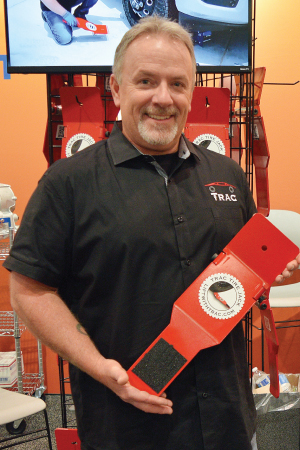 Hometown: Brighton, Colorado
Hometown: Brighton, Colorado
Job Title: President/Owner
Product/Company: TRAC Tire Rotation Assistance Cart
SN: What’s your latest project? What’s in your driveway/garage/studio, etc.?
Kevin Robinson: Currently I am working on my ’06 Jeep LJ. We stretched out the axles to increase the wheelbase and added some aluminum armor and ORI struts. I have had this for a little over five years, and it has come a long way.
SN: Tell us a bit about your background: Where you grew up, how you got into the industry, and how many years you’ve been in it.
KR: I grew up in New Jersey. I’ve always had a passion for unique cars and trucks and have been through a fair share of them through the years. I then moved to Florida to get a pilot’s license. My career paths changed, and I moved to Colorado in 1996 when I started my new career in automotive paintless dent repair. I still repair door dings and hail cars to this day. I also still go boating, motorcycling, Jeeping, and have the passion to be outdoors.
SN: What was the inspiration/motivation for your product?
KR: The motivation for the Tire Jack came from needing a solution in the industry to provide safety in the shop, whether it be at home or in the professional workplace. Now more people can benefit from the use of this tool. I even saw a small female try to pick up a tire at one of our shows. The tire weighed more than her. When she used the tool, she was able to do the task. Her father was impressed and bought the Tire Jack and told her she can now do the tires on the family vehicle.
SN: How long did it take to develop your product? Were there any difficulties you had to work through?
KR: Development is always still in progress. Our team came to us with the idea, and we then made a few changes for more leverage and to this day we are still doing some refinements. Even for such a simple tool, there can always be changes. The most challenging part of this is how to get it out to the masses and to get them to understand its benefits. Once it is seen, people get it and want it.
SN: What have you learned from the Launch Pad experience that you hadn’t known before? What’s the best piece of advice you’ve received?
KR: Launch Pad has opened doors to some people in the industry that I would have never thought I would have access to—the judges and their input and expertise. Their advice is real-world and can make a big impact to one’s business. I had one judge mentor me through a licensing agreement with a new distributor. Without the help, I may not have gotten such a good deal in the agreement.
SN: If you should win the competition, what do you plan to do with the money?
KR: If I win for the TRAC Tire Jack, I plan on building my inventory and doing way more advertising. Currently, when we do a show, we sell the product easily and people are learning the brand, but we need to be in front of a much larger audience to make a change in the industry. Advertising will do just that.
SN: What advice would you give to folks who are thinking about competing in the future?
KR: Don’t think you won’t get in. Submit your idea, and go for it! I had a guy stop by my booth last year with an idea. I loved it and told him to enter. He did and he made it to the top 15! He’s Robert Carale, the founder of the Airflex Automatic Tire Inflator.
SN: When you’re not at work, where will we find you, and what will you be doing?
KR: When I am not at work I will most likely be with the family and friends at the lake or doing a 500-mi. day-trip motorcycle ride in the Colorado Rockies. We enjoy going to the Bronco games and visiting with family in the mountains. We are a very busy and active family with twin boys attending their second year of college.
Launch Pad 2023: How to Enter
Launch Pad is open only to legal residents of the United States and the District of Columbia age 18 years or older (residents of Alabama and Nebraska must be 19 or older) and who have a valid email address. Applicants need not be SEMA members. The presenter must be the business’ owner, its leading executive (i.e., president, CEO, CFO, COO) or vice president. The business must offer a product or service that is a functioning prototype, a functioning concept or a production model currently for sale.
For more information, visit www.sema.org/sema_launchpad.





